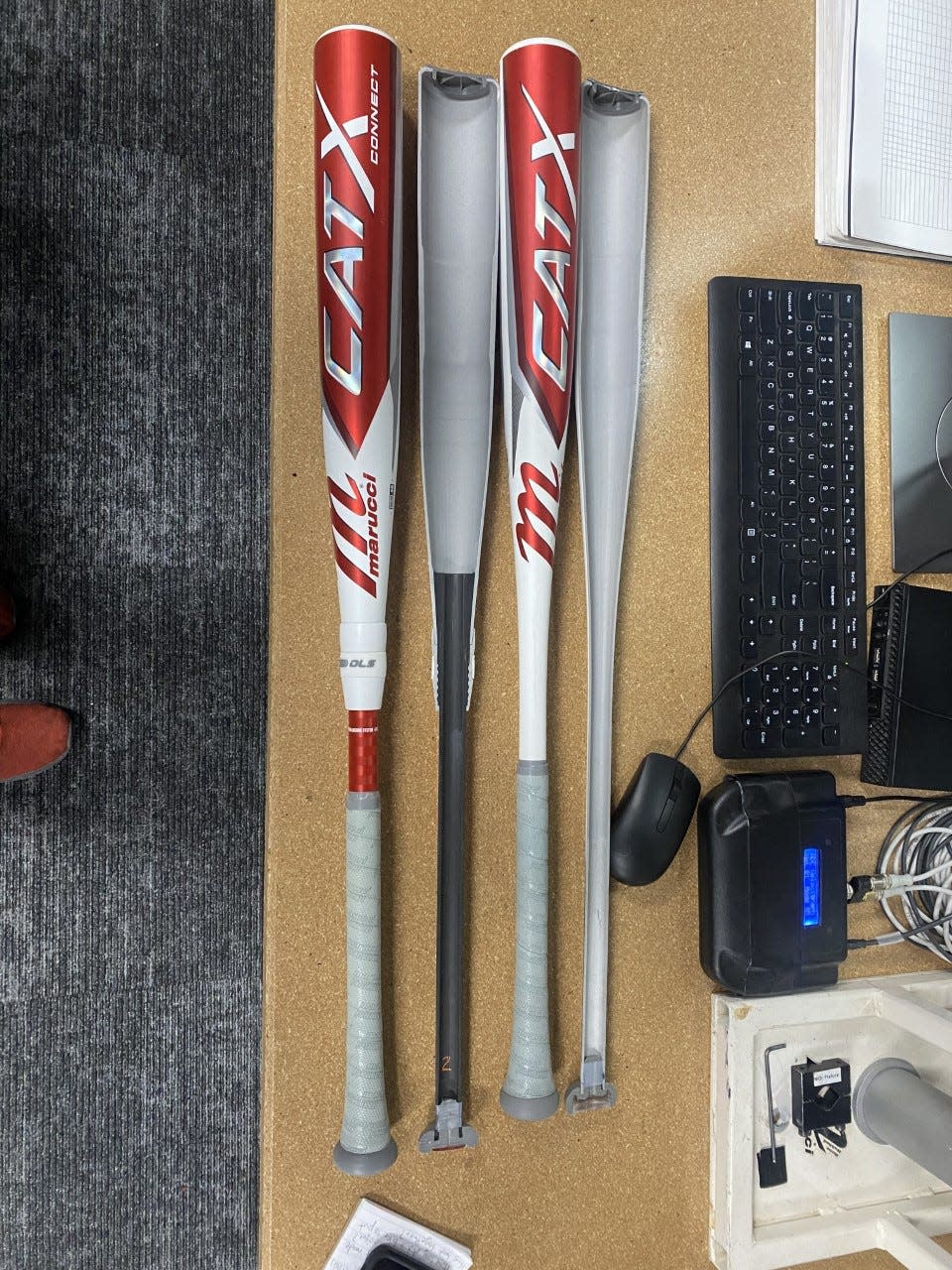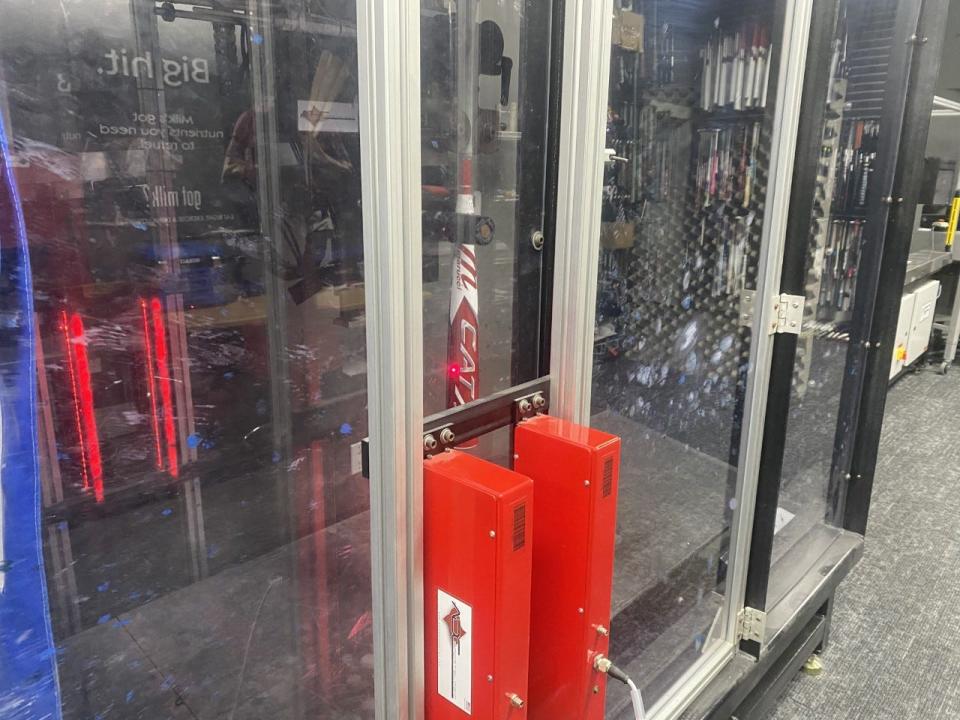Science of hitting: Why LSU baseball's bats have helped propel the Tigers' offense in 2023
BATON ROUGE – Holding the bat reminded me of the good old days.
Weekend tournaments in the sweltering heat. Friday nights under the lights in Orleans. Tuesday evening practices in the batting cages after school.
All of those memories rushed back to me like a flood. But this time I wasn't in Cape Cod, Massachusetts, I was at the Cannon Room inside the Baseball Performance Lab at Marucci Sports' headquarters in Baton Rouge – feeling out the 2023 Marucci CATX BBCore one-piece aluminum and two-piece hybrid bats, both used by No. 1 LSU baseball.
The one in my hand first is the CATX one-piece aluminum. It may be an inch longer than what I would have used in high school, but it's light and comfortable and its weight felt evenly distributed. It's the weapon of Paxton Kling's choice.
The second bat I lay on my shoulder is the CATX Connect, a two-piece hybrid, meaning that it has a composite handle and an aluminum barrel. It's too heavy and end-loaded for me, but for sluggers like Dylan Crews, Tommy White or Jared Jones, its weightier end is perfect for mashing 400-foot moonshots over Alex Box Stadium's walls.
Regardless of my preferences, the latest version of Marucci's signature aluminum bats has been a key factor in LSU baseball's success at the plate, as the program has had a partnership with the company since 2018. To start this year, the Tigers have mashed 35 home runs, posted a .579 team-slugging percentage and won two of three games over Texas A&M to begin SEC play this past weekend.
LSU will look to continue its success at the plate with these advanced weapons when it hosts No. 3 Arkansas at Alex Box Stadium for a three-game series starting on Friday (12 p.m., SEC Network).
"I was with Wilson and Louisville Slugger my whole career at my previous stops and it didn't take too long to figure out like 10 seconds after I was hired the level of service (Marucci) gives LSU baseball. (I'm) very thankful for the relationship with them," LSU coach Jay Johnson said. "The intelligence behind the whole operation and how they put everything together is a big asset to us."
What makes Marucci's new bats unique
Before there was the CATX, Marucci had the CAT5, 6, 7, 8 and 9. And with each new bat came slight upgrades, as Marucci would release a new version every two years.
But with the CATX, Marucci wanted to be bold with their upgrades.
Ryder Dupuis, Marucci's Vice President of Product Development, said that after extensive research and testing, Marucci moved the balance point of the CATX – the bat's center of gravity – closer to the hands by an entire inch, and the CATX Connect by half an inch.
The changes resulted in both bats having a more even weight distribution. Even the two-piece hybrid, designed to be heavier on its end, became more balanced.
"The only way to change that much in a balance point or an MOI (moment of inertia) is to make some pretty drastic changes to your overall shape, where the weight's distributed across the barrel, everything like that," Dupuis said.
But Dupuis wasn't done making changes. He thinned out the walls around the sweet spot of the one-piece and two-piece bats to help with hitters' quality of contact on balls not made in the sweet spot. The further away the wall was from the sweet spot, the thinner it became.
"Those (thinner) walls are able to flex in a little bit easier and give you higher performance, even though you didn't hit it on the sweet spot," Dupuis said.
Additionally, Dupuis gradually widened the end of the bat's handle to create a more comfortable grip by the knob. He also added eight grams of gel to the knob of both bats, significantly diminishing any vibrations or sting hitters feel in their hands when they connect with the ball, especially when the ball doesn't land on the sweet spot.
"It's basically called our Liquid Gel Dampening Knob," Dupuis said. "So as vibrations travel down the bat, they actually get absorbed into that gel."

Since the CATX and CATX Connect have been released, Dupuis and Justin Cryer, Marucci's Director of College Sales, have only received rave reviews. Cryer and Dupuis believe that at least 75% of the players on each college team that received the CATX or CATX Connect at the end of last year switched over to them despite how late it was in the season.
LSU was among those teams that immediately began using the bats. The Tigers started swinging them during the Hattiesburg Regional, months before they were available in the marketplace.
"Oklahoma made it all the way to the last game of the year and they had their entire lineup swinging a CATX when the whole year they swung a CAT9," Cryer said. "...Their postseason with the CATX was way better than their offense was with the CAT9. TBD if it was bat-oriented or player-oriented, but at the same time it doesn't ever hurt for us and it's a confidence builder for the kids."
LSU BASEBALL CHALLENGERS5 SEC teams poised to challenge No. 1 LSU baseball entering conference play
LSU BASEBALL ANALYTICS:LSU baseball analytics: What technology, data do the Tigers use?
PITCHERS UTILIZING TECH:LSU baseball analytics: How Tigers use technology to get the most out of pitchers
How Marucci tests its bats
Every metal bat Marucci makes gets tested and perfected, as each length of a model they work on gets shipped to a lab at Washington State University that certifies the bats for in-game use. So it's up to Dupuis to improve each bat's performance while also staying within the NCAA's Batted Ball Coefficient of Restitution standards, also known as BBCOR.
"They implemented BBCOR back in 2011 to make (the bats) more wood-like performing," Dupuis said. "The older bats they talked about in the 90s, Guerilla ball. Those bats were outrageous and hit balls way harder."
Dupuis has a variety of high-tech tools he can use to test bats. There's the Performance Cannon, which helps determine whether a bat is staying within BBCOR standards, and the Compression Testing System, a mechanism that measures the stiffness of a bat's barrel.
But the biggest device Dupuis uses is the Durability Cannon, which can shoot baseballs up to 200 mph at a bat to test its durability. Dupuis loads the cannon with balls, sets the bat with the knob facing up and points a laser within the cannon toward the area of the bat he wants the ball to get shot at.

After the ball collides with the bat, making a thunderous clang, a computer hooked up to the machine calculates the impact speed made by the ball hitting the bat.
"If I had to guess, I've probably had close to a million shots through this thing," Dupuis said.
The state-of-the-art technology Marucci uses to test its aluminum bats is the driving factor behind how the CATX and CATX Connect were developed to become LSU's primary bats of choice.
Maybe if I had these bats, I could have played college baseball.
"With advancements in technology over the years, you can make bats as good as you want," Dupuis said.
Koki Riley covers LSU sports for The Daily Advertiser and the USA TODAY Sports South Region. Email him at kriley@theadvertiser.com and follow him on Twitter at @KokiRiley.
This article originally appeared on Lafayette Daily Advertiser: LSU baseball: Marucci bats have helped Tigers' 2023 success


